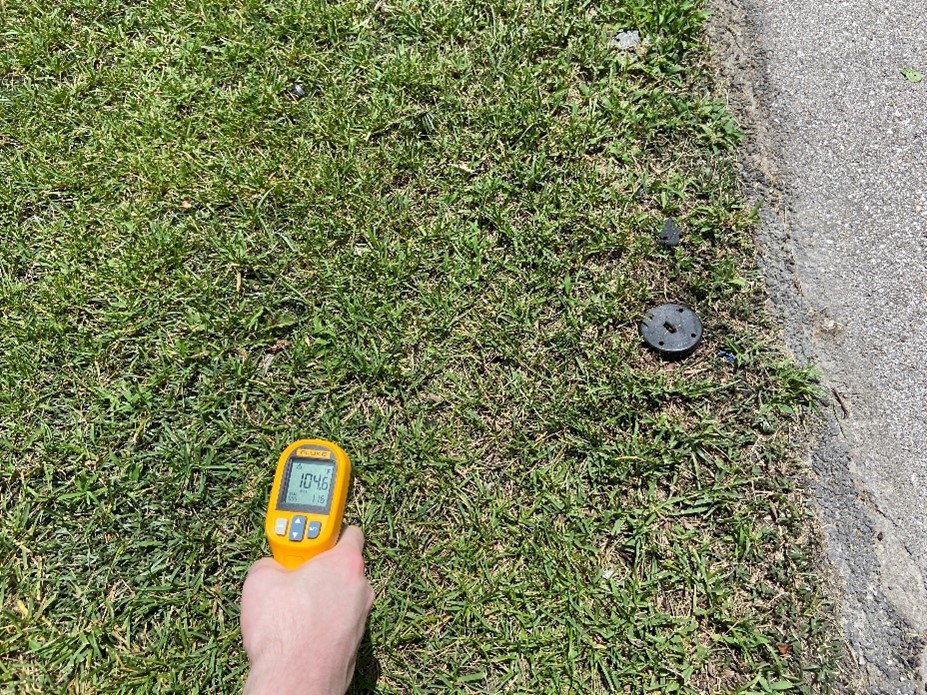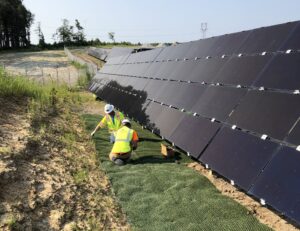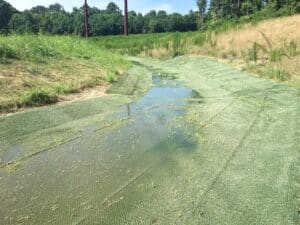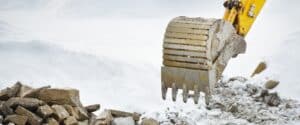InstaTurf Can Help Manage the Heat
Heat is a major concern when it comes to our relationship with the environment. At InstaTurf®, we want to ensure that our effect on an area’s ecology is as positive as possible. We know that one of the major contributors to increased atmospheric temperatures is radiant heat from surfaces such as asphalt and concrete. We went out with an infrared thermometer to test how different surfaces react to the heat to understand just how we fit into the natural world.
To start things off, we needed a baseline to give us some context for what our results would be once we started measuring.
What is the temperature today?

As you can see, we couldn’t have chosen a better day to test heat buildup on surfaces. Keep in mind that the ambient temperature sat somewhere around 95 Fahrenheit for these readings. You can see just how much heat builds up on sunlight-exposed surfaces in this heat by taking a reading of unshaded asphalt.
What is the temperature of asphalt?

At 133 degrees Fahrenheit, asphalt and similar surfaces absorb a significant amount of heat throughout a hot summer day. To put that into perspective, the internal core temperature of a medium rare steak must be between 130- and 135-degrees Fahrenheit.
We measured asphalt that had been in the shade all day as well.

At 94 degrees fahrenheit, the temperature of the shaded asphalt was about the same as the ambient temperature. That’s almost a 40-degree difference in temperature between shaded asphalt and unshaded asphalt. Take these readings as a high-water indicator for temperature. Ideally, your erosion control solution handles heat more efficiently than bare asphalt—but does it?
Does InstaTurf get hot?
We installed InstaTurf ShearForce as a living parking lot specifically to combat high surface temperatures and test just where we could take the product. In full sunlight, our turf proved to be quite a bit cooler than its asphalt counterpart.

As a matter of fact, InstaTurf in full sunlight was almost 30 degrees Fahrenheit cooler than asphalt in full sunlight. The combination of synthetic turf and natural vegetation appears to reflect and diffuse heat far more efficiently than asphalt. Because vegetation contains water, it takes a significant amount of thermal energy to change temperature, leading to cooler surface temperatures on hot days. The infrared reflective pigments in InstaTurf are a main contributor to this reduced heat buildup.
But what about shaded InstaTurf?

Even in the shade, InstaTurf and vegetation manage to keep the temperature below 90 degrees Fahrenheit. Remember, the ambient temperature was sitting around 95 Fahrenheit for these readings.
Does rock riprap get hot?
It’s clear that combined vegetation and InstaTurf ShearForce products are far superior at reducing surface temperature compared to asphalt. But we wanted to know how InstaTurf stacks up in the erosion control space. We set out to test a rock riprap installation to see how one of the most widely used erosion control solutions handles the heat.

At over 122 degrees Fahrenheit, rock riprap proved to be more like asphalt in how it handles surface heat than InstaTurf and natural vegetation. An 18-degree difference is significant, particularly when you consider the applications where rock riprap and InstaTurf are likely to be deployed.
How does water temperature affect local ecology?
If placed along bodies of water, the thermal properties of applied erosion control solutions are ecologically critical. When water temperatures increase, there are a number of detrimental effects on local wildlife.
As water temperature increases, the oxygen level of the water decreases, making the water less able to support healthy fish populations. Some fish, such as certain trout species, are particularly sensitive to changes in water temperature. Fish embryos and eggs are generally more sensitive to changes in water temperature than adolescent or mature fish, which means that a change in water temperature due to, say, the installation of rock riprap, could have a detrimental effect on the populations of certain fish species. Unfortunately, it is often the case that more ecologically precarious native species are unable to handle the increased water temperature. At the same time, certain invasive species, such as the Asian carp, are more adaptable to temperature shifts and are consequently able to multiply unimpeded due to the vacuum created in the ecosystem by native species dying off.
It has been observed that an increase in temperature surrounding artificial breakwater riprap installations leads to decreased biodiversity and an altered microclimate. If fish have trouble hatching and growing to maturity after fertilization, the ecological effects on an area can be devastating. With reduced local fish populations, algae and other producer species aren’t as likely to be consumed for their nutrients, leading to a disrupted food chain. In addition, if algae blooms are allowed to flourish, they can release harmful toxins that harm fish and humans alike. Runaway algae blooms consume oxygen and block sunlight to the depths below, exacerbating the issues increased water temperature brings.
These increased temperatures don’t only affect aquatic wildlife. According to ASTM C1055 (the Standard Guide for Heated System Surface Conditions that Produce Contact Burn Injuries), surface temperatures in excess of 118 degrees Fahrenheit (48 Celsius) are unsuitable for prolonged human contact. Land animals don’t like the excess surface temperatures either. If conditions near water sources are unsuitable for prolonged contact, local wildlife will have trouble safely drinking and eating from that source, and the usual nutrient exchange between land animals and the aquatic ecosystem will break down. Even in the absence of nearby aquatic or terrestrial wildlife, increased surface temperatures in an area lead to increased atmospheric temperatures, thereby contributing to the harmful effects of global climate change.
InstaTurf helps manage heat
These readings confirm what we’d hoped: InstaTurf ShearForce offers erosion control without increasing surface temperatures to an unsafe or ecologically harmful degree. The product appears to work more like regular vegetation than hard armor surfaces such as rock, asphalt, and concrete. Visit our products page to see how InstaTurf fits into your project and your environment.









